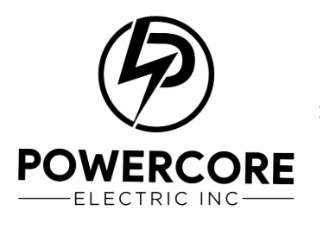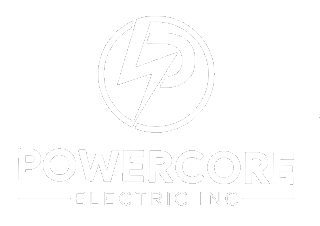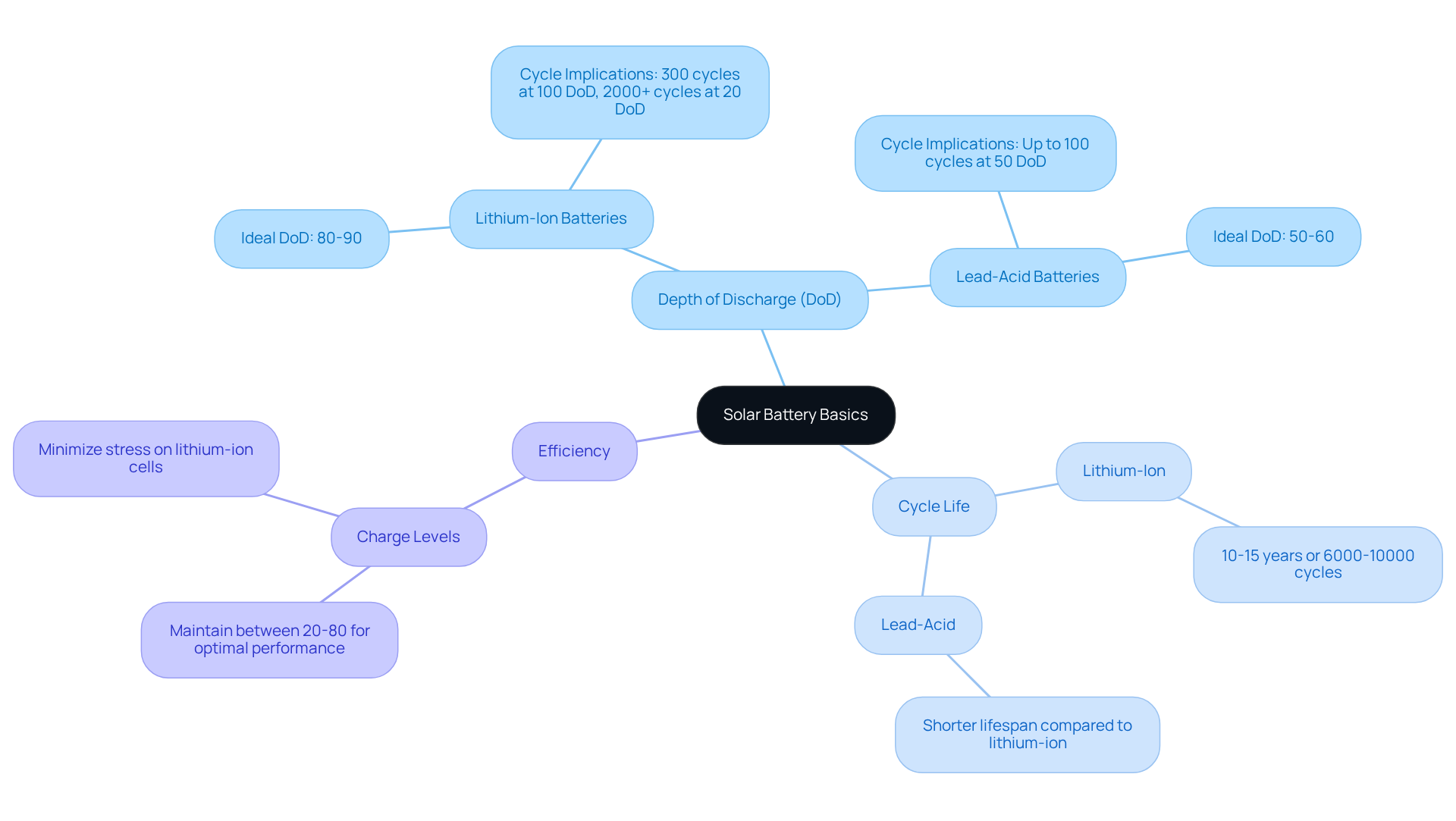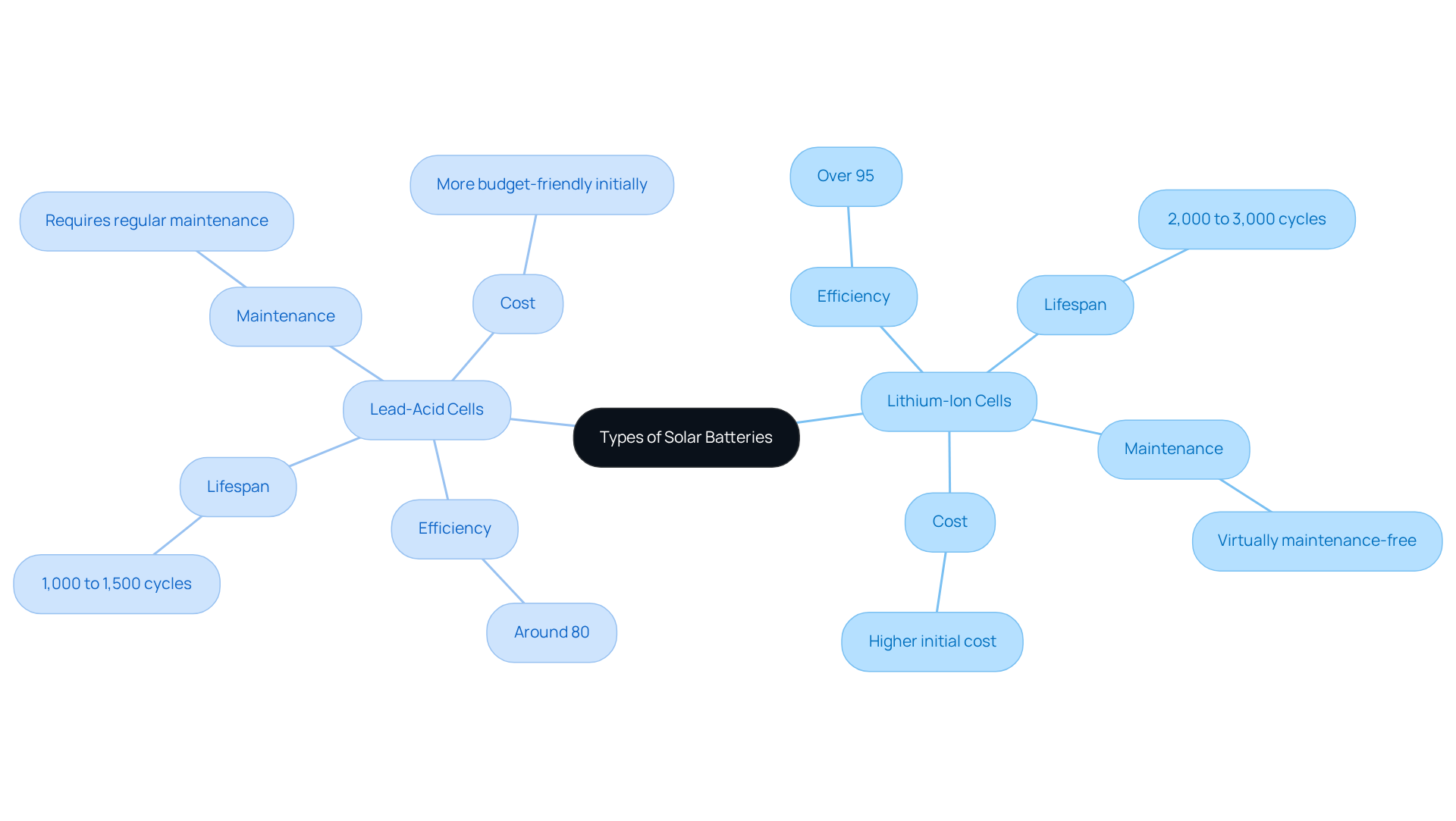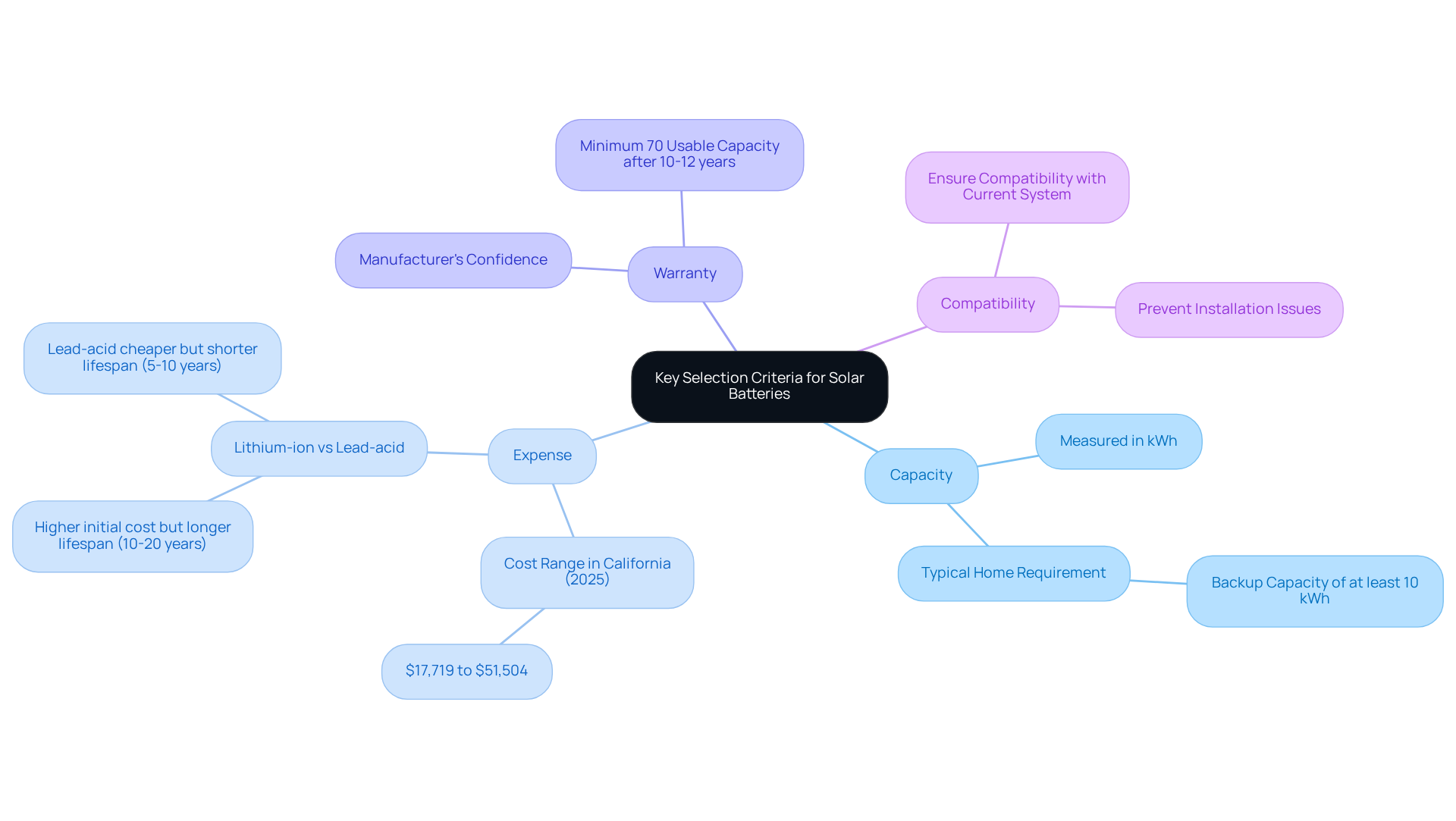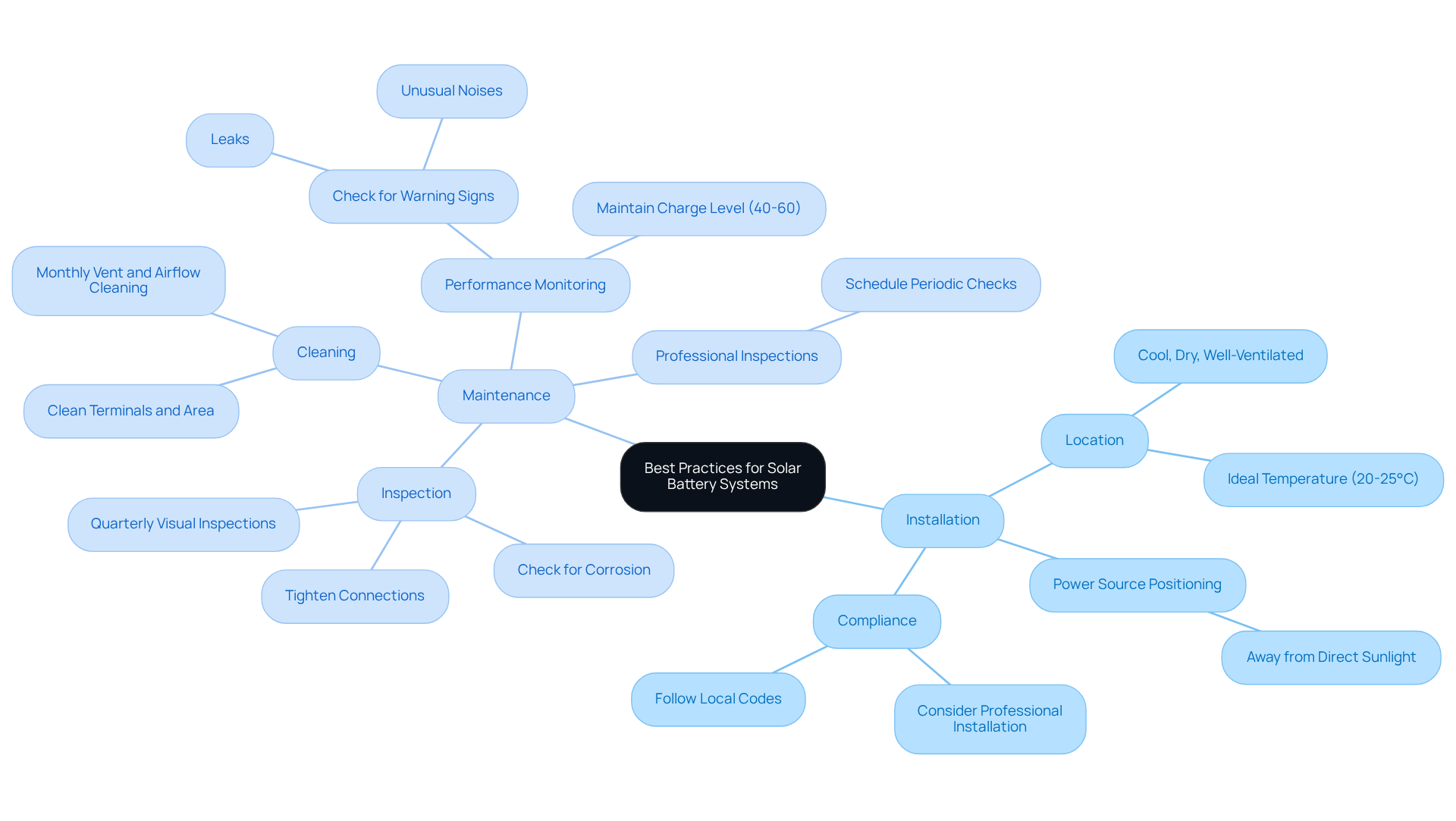Overview
We understand that rising energy bills can be a significant concern for homeowners. That’s why exploring sustainable solutions, like solar energy, is so important. Among the options available, lithium-ion batteries stand out as the best choice for solar systems. Their high efficiency, longer cycle life, and lower maintenance requirements make them a nurturing option compared to traditional lead-acid batteries.
Imagine having the ability to harness the sun’s energy, providing you with greater autonomy over your energy needs. Lithium-ion batteries offer remarkable benefits, including:
- Deeper depth of discharge
- Extended cycle life
- Impressive efficiency
These features not only enhance your energy independence but also lead to meaningful savings over time.
Together, we can work towards a more sustainable future. By choosing lithium-ion batteries, you are not just making a smart investment; you are embracing a lifestyle that prioritizes efficiency and care for our planet. If you’re ready to explore how solar energy can transform your home, let’s connect and discuss the best options for you.
Introduction
Navigating the maze of options and technical specifications when choosing the right battery for a solar energy system can be overwhelming. We understand that with the increasing emphasis on energy independence and sustainability, homeowners are presented with a unique opportunity to enhance their power management through effective solar battery solutions.
However, with various types of batteries available, each with distinct advantages and drawbacks, how can you determine the best fit for your specific needs?
This guide delves into the essentials of solar batteries, offering insights that empower you to make informed decisions for a more efficient and cost-effective energy future.
Together, we can explore the path to sustainable energy solutions that not only reduce your energy bills but also contribute to a greener planet.
Understand Solar Battery Basics
Solar storage units are essential components that act as the best battery for solar systems, helping to retain the power generated by solar panels and enabling homeowners to maximize their efficiency. We understand that managing energy costs can be a concern, and these devices allow you to utilize stored power during peak demand periods or outages, playing a crucial role in power management. Let’s explore some key terms that can help you make informed decisions:
- Depth of Discharge (DoD): This important metric indicates the percentage of energy that can be safely drawn from the battery without causing damage. For lithium-ion and Lithium Iron Phosphate (LFP) cells, an ideal DoD typically ranges from 80% to 90%, allowing for greater usable energy. In contrast, lead-acid cells operate best at a DoD of 50-60%. By effectively managing the best battery for solar, you can significantly extend the lifespan of your energy storage units; for instance, a unit discharged to only 20% DoD can exceed 2,000 cycles, while one discharged to 100% may only last around 300 cycles.
- Cycle Life: This term refers to the number of complete charge and discharge cycles an energy storage device can undergo before its capacity diminishes significantly. Lithium-ion batteries, like the LG Chem RESU, generally offer a longer cycle life compared to lead-acid options, with many capable of lasting 10-15 years or 6,000-10,000 cycles under optimal conditions. This longevity can provide peace of mind as you invest in your energy future.
- Efficiency: This measures how much of the stored power can be effectively utilized. Greater efficiency means less energy waste during the charging and discharging processes. For example, maintaining charge levels between 20-80% minimizes stress on lithium-ion cells, preserving their capacity and enhancing overall efficiency.
Alongside these key metrics, consider exploring other energy storage options like the Sonnen Eco and NeoVolta NV14, which offer unique features and advantages tailored to your needs. Understanding the broader implications of your energy storage choice, including the and participation in virtual power plant business models, can also enhance the value of your investment. As the renewable sector continues to evolve, many homeowners are increasingly valuing autonomy and cost reductions. Together, we can navigate these choices, making informed decisions about power storage options that best suit your lifestyle and goals.
Explore Different Types of Solar Batteries
When considering the best battery for solar photovoltaic storage solutions, many homeowners understandably weigh their options between lithium-ion and lead-acid batteries, each offering unique characteristics that can significantly impact your energy experience.
- Lithium-Ion Cells: Known for their impressive power density and efficiency, lithium-ion cells can achieve efficiencies exceeding 95%. With a lifespan of 2,000 to 3,000 cycles, they can provide reliable service for around 10 years. Their lightweight design and low maintenance needs make them a popular choice for modern solar energy systems. Moreover, they can be charged quickly—often within just 1 to 2 hours—and support opportunity charging, which is particularly beneficial for those with multi-shift operations.
- Lead-Acid Cells: On the other hand, while lead-acid cells tend to be more budget-friendly initially, they have a shorter lifespan of 1,000 to 1,500 cycles, typically lasting between 3 to 5 years. Their efficiency is around 80%, and they are heavier, requiring regular maintenance, such as monitoring electrolyte levels. Despite these challenges, lead-acid cells can still serve specific applications, especially where cost is a primary consideration.
As we look towards 2025, the trend is shifting favorably towards lithium-ion cells, thanks to their superior performance and longevity. With the projected to reach an estimated USD 14.35 billion, the advantages of lithium-ion technology are becoming increasingly clear.
We understand that choosing the best battery for solar storage solutions can feel overwhelming. It’s essential to consider your budget, available space, and how often you consume power. The right choice can significantly enhance your energy autonomy and efficiency. Together, let’s explore these options and find the best fit for your home, ensuring you feel supported every step of the way.
Evaluate Key Selection Criteria
When considering solar batteries, it’s essential to reflect on several key criteria to ensure you make a well-informed decision that aligns with your energy needs and financial goals:
- Capacity: Measured in kilowatt-hours (kWh), capacity reveals how much energy the battery can store. Understanding your household’s energy consumption patterns is crucial. For instance, a typical home might require a power source that can sustain essential circuits during outages, often necessitating a backup capacity of at least 10 kWh. By evaluating this, you can ensure your family stays comfortable during unexpected disruptions.
- Expense: The cost of photovoltaic energy storage systems in California in 2025 ranges from $17,719 to $51,504, influenced by factors like the type of energy storage and installation specifics. While may present a higher initial expense, their lifespan of 10-20 years and efficiency can translate into significant savings over time. This makes them a valuable investment for your energy independence.
- Warranty: A longer warranty period often reflects a manufacturer’s confidence in their product. Look for warranties that guarantee a minimum of 70% usable capacity after 10-12 years, as most 10 kW energy storage systems offer this assurance. This can provide peace of mind regarding the longevity and reliability of your investment, knowing that your choice is backed by the manufacturer.
- Compatibility: It’s vital to ensure the power source is compatible with your current energy system and inverter. This compatibility is essential to prevent potential issues during installation and operation, which can lead to unexpected costs and complications. We understand that navigating these details can be overwhelming, but addressing them upfront can save you stress later.
By thoughtfully evaluating these criteria, you can select the best battery for solar that matches your energy aspirations and financial considerations. Together, we can enhance your home’s energy autonomy and durability, paving the way for a more sustainable future. If you have questions or need guidance, don’t hesitate to reach out—we’re here to support you every step of the way.
Implement Installation and Maintenance Best Practices
To ensure your solar battery system operates efficiently, we understand that it’s essential to adhere to these best practices for installation and maintenance:
-
Installation:
- First and foremost, select a location that is cool, dry, and well-ventilated to prevent overheating. Excessive heat can accelerate battery degradation by 10-15% compared to moderate climates, and we want to protect your investment.
- It’s best to firmly attach the power source away from direct sunlight to preserve ideal temperature conditions, ideally between 20-25°C (68-77°F).
- Remember to comply with all local codes and regulations during installation. If the setup feels complex, consider hiring a professional; this ensures safety and efficiency, giving you peace of mind.
-
Maintenance:
- Regularly inspect battery connections for corrosion and ensure they are tight. Loose connections can disrupt electricity flow and pose fire hazards, and we care about your safety.
- Cleaning the terminals and surrounding area is important to prevent dust buildup, which can impact performance.
- Keep an eye on the power source’s performance and check for warning signs like unusual noises or leaks. These may indicate deeper issues that need attention.
- Scheduling periodic professional inspections is a proactive step to ensure everything is functioning correctly. These checks can help identify potential problems before they escalate, ensuring your system remains reliable.
By following these best practices, you can significantly enhance the reliability and longevity of the best battery for solar systems. Together, let’s ensure it meets your , providing you with the independence and peace of mind you deserve.
Conclusion
Choosing the right battery for solar energy storage is a pivotal decision for homeowners who want to enhance their energy efficiency and independence. We understand that navigating this choice can feel overwhelming, but this guide has explored the essential aspects of solar batteries, including their types, key selection criteria, and best practices for installation and maintenance. By understanding these components, you can make informed choices that align with your energy needs and financial goals.
Key insights covered include:
- The importance of depth of discharge (DoD)
- Cycle life
- Efficiency in determining the best battery for solar systems
Lithium-ion batteries stand out for their longevity, efficiency, and minimal maintenance, while lead-acid batteries offer a more budget-friendly option with certain limitations. Evaluating capacity, expense, warranty, and compatibility further aids in selecting the most suitable energy storage solution for your unique circumstances.
Ultimately, investing in a solar battery not only contributes to your personal energy autonomy but also supports broader sustainability efforts. By prioritizing the right battery choice and adhering to proper installation and maintenance practices, you can enjoy the benefits of reliable, renewable energy for years to come. Together, let’s embrace the opportunity to enhance your home’s energy efficiency and independence, and take the next step towards a sustainable future.
